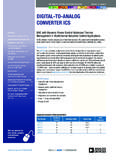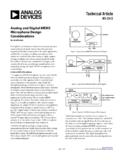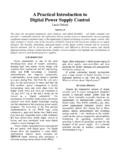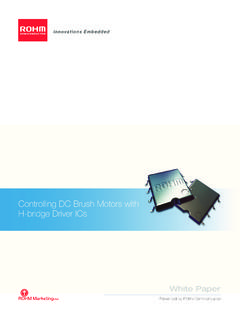Transcription of APR8 - Principles of Sigma-Delta Modulation for …
1 MOTOROLAAPR8by Sangil Park, Ph. D. Strategic ApplicationsDigital Signal Processor Operation Motorola digital Signal Processors Principles of Sigma-Delta Modulation for Analog-to- digital Converters Motorola reserves the right to make changes without further notice to any products here-in. Motorola makes no warranty, representation or guarantee regarding the suitability ofits products for any particular purpose, nor does Motorola assume any liability arising outof the application or use of any product or circuit, and specifically disclaims any and allliability, including without limitation consequential or incidental damages.
2 Typical pa-rameters can and do vary in different applications. All operating parameters, including Typicals must be validated for each customer application by customer s technical ex-perts. Motorola does not convey any license under its patent rights nor the rights of oth-ers. Motorola products are not designed, intended, or authorized for use as componentsin systems intended for surgical implant into the body, or other applications intended tosupport or sustain life, or for any other application in which the failure of the Motorolaproduct could create a situation where personal injury or death may occur.
3 Should Buyerpurchase or use Motorola products for any such unintended or unauthorized application,Buyer shall indemnify and hold Motorola and its officers, employees, subsidiaries, affili-ates, and distributors harmless against all claims, costs, damages, and expenses, andreasonable attorney fees arising out of, directly or indirectly, any claim of personal injuryor death associated with such unintended or unauthorized use, even if such claim allegesthat Motorola was negligent regarding the design or manufacture of the part. Motorolaand are registered trademarks of Motorola, Inc.
4 Motorola, Inc. is an Equal Opportuni-ty/Affirmative Action Employer. Table of Contents MOTOROLAiii I ntroductionConventional Analog-to- digital ConvertersQuantization Error in A/D ConversionOversampling and Decimation BasicsDelta ModulationSigma-Delta Modulation for A/D Converters (Noise Shaping) of Sigma-Delta Modulation inZ-Transform DomainDigital Decimation Design as a Section Decimation FIR FilterMode Resolution by Filtering the Comb-Filter Out put with Half-Band FiltersSummary SECTION 1 SECTION 2 SECTION 3 SECTION 4 SECTION 5 SECTION 6 SECTION 7 SECTION 8 SECTION 9 REFERENCES1-12-13-14-15-16-16-67-17-57-1 08-19-1 References-1 MOTOROLAv Illustrations Generalized Analog-to- digital Conversion ProcessConventional Analog-to- digital Conversion ProcessSpectra of Analog and Sampled SignalsQuantization ErrorNoise Spectrum of
5 Nyquist SamplersComparison Between Nyquist Samplers and 2X OversamplersAnti-Aliasing Filter Response and Noise Spectrum of Oversampling A/D ConvertersFrequency Response of Analog Anti-Aliasing FiltersSimple Example of Decimation ProcessDelta Modulation and DemodulationDerivation of Sigma-Delta Modulation from Delta Modulation Block Diagram of Sigma-Delta Modulation S-Domain Analysis of Sigma-Delta Modulator Block Diagram of First-Order Sigma-Delta A/D ConverterInput and Output of a First-Order Sigma-Delta Modulator Z-Domain Analysis of First-Order Noise ShaperSpectrum of a First-Order Sigma-Delta Noise Shaper2-22-32-53-33-34-34-54-64-75-26-16 -26-36-56-66-76-9 Figure 2-1 Figure 2-2 Figure 2-3 Figure 3-1 Figure 3-2 Figure 4-1 Figure 4-2 Figure 4-3 Figure 4-4 Figure 5-1 Figure 6-1 Figure 6-2 Figure 6-3 Figure 6-4 Figure 6-5 Figure 6-6 Figure 6-7 vi MOTOROLA Illustrations Second-Order and Third-Order Sigma-Delta Noise Shapers Multi-Order Sigma-Delta Noise ShapersSpectra of Three Sigma-Delta Noise ShapersDigital Decimation ProcessBlock Diagram of One-Stage Comb Filtering
6 Process Transfer Function of a Comb-FilterCascaded Structure of a Comb-FilterAliased Noise in Comb-Filter Output(a) Comb-Filter Magnitude Response inBaseband (b) Compensation FIR Filter Magnitude ResponseFIR Filter Magnitude ResponseAliased Noise Bands of FIR Filter OutputSpectrum of a Third-Order Noise Shaper (16384 FFT bins)Spectrum of Typical Comb-Filter Output (4096 FFT bins)Decimation Process using a Series of Half Band Filters Figure 6-8 Figure 6-9 Figure 6-10 Figure 7-1 Figure 7-2 Figure 7-3 Figure 7-4 Figure 7-5 Figure 7-6 Figure 7-7 Figure 7-8 Figure 8-1 Figure 8-2 Figure 8-3 6-106-136-137-47-67-77-87-97-117-117-127 -138-28-38-5 MOTOROLAvii Tables Table 8-1 Parameters for Designing Half-Band Filters8-4 MOTOROLA1-1 Since the A/D convertersare based ondigital filteringtechniques,almost 90% ofthe die isimplemented indigital circuitrywhich enhancesthe prospect ofcompatibility.
7 SECTION 1 T he performance of digital signal processing andcommunication systems is generally limited by theprecision of the digital input signal which is achievedat the interface between analog and digital informa-tion. Sigma-Delta ( ) Modulation based analog-to- digital (A/D) conversion technology is a cost effectivealternative for high resolution (greater than 12 bits)converters which can be ultimately integrated on dig-ital signal processor ICs. Although the Sigma-Delta modulator was first intro-duced in 1962 [1], it did not gain importance untilrecent developments in digital VLSI technologieswhich provide the practical means to implement thelarge digital signal processing circuitry.
8 The increas-ing use of digital techniques in communication andaudio application has also contributed to the recent in-terest in cost effective high precision A/D requirement of analog-to- digital (A/D) interfaces iscompatibility with VLSI technology, in order to providefor monolithic integration of both the analog and digi-tal sections on a single die. Since the A/Dconverters are based on digital filtering techniques,almost 90% of the die is implemented in digital circuit-ry which enhances the prospect of compatibility.
9 Introduction 1-2 MOTOROLAA dditional advantages of such an approach in-clude higher reliability, increased functionality, andreduced chip cost. Those characteristics are com-monly required in the digital signal processingenvironment of today. Consequently, the develop-ment of digital signal processing technology ingeneral has been an important force in the devel-opment of high precision A/D converters which canbe integrated on the same die as the digital signalprocessor itself. The objective of this applicationreport is to explain the technology which is im-plemented in the DSP56 ADC16, and show thesuperior performance of the converter comparedto the performance of more conventional imple-mentations.
10 Particularly, this application notediscusses a third-order, noise-shaping oversam-pling structure. Conventional high-resolution A/D converters, suchas successive approximation and flash type con-verters, operating at the Nyquist rate (samplingfrequency approximately equal to twice the maxi-mum frequency in the input signal), often do notmake use of exceptionally high speeds achievedwith a scaled VLSI technology. These Nyquist sam-plers require a complicated analog lowpass filter(often called an anti-aliasing filter) to limit the maxi-mum frequency input to the A/D, and sample-and-hold circuitry.








